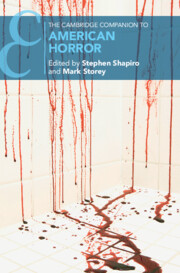Book contents
- The Cambridge Companion to American Horror
- The Cambridge Companion to American Horror
- Copyright page
- Contents
- Acknowledgments
- Contributors
- Introduction
- Part I Histories
- 1 Slavery
- 2 Capitalism
- 3 Religion and Spirituality
- 4 Settlement and Imperialism
- 5 Censorship and State Regulation
- 6 Schlock, Kitsch, and Camp
- Part II Genres
- Index
- Cambridge Companions To …
- References
1 - Slavery
from Part I - Histories
Published online by Cambridge University Press: 21 July 2022
- The Cambridge Companion to American Horror
- The Cambridge Companion to American Horror
- Copyright page
- Contents
- Acknowledgments
- Contributors
- Introduction
- Part I Histories
- 1 Slavery
- 2 Capitalism
- 3 Religion and Spirituality
- 4 Settlement and Imperialism
- 5 Censorship and State Regulation
- 6 Schlock, Kitsch, and Camp
- Part II Genres
- Index
- Cambridge Companions To …
- References
Summary
Modern Black horror literature and film depict the complex mechanisms of social death threatening contemporary African Americans. Drawing on slavery to metaphorize social death, texts like Linden Hills and Stigmata, films such as The House Invictus and popular media like Lovecraft Country and “This Is America” also reveal how the lure of the American Dream seduces African Americans into colluding in their own suffering and the suffering of others like them. Yet even as slavery is presented as a point of historical horror, it is also presented as a source of ancestral knowledge, as African American artists rewrite the history of Black slave resistance to urge modern audiences to a much needed and long-overdue revolution.
Keywords
- Type
- Chapter
- Information
- The Cambridge Companion to American Horror , pp. 15 - 28Publisher: Cambridge University PressPrint publication year: 2022
References
Works Cited
- 1
- Cited by



